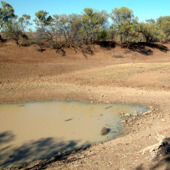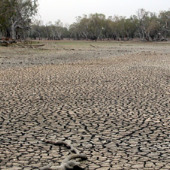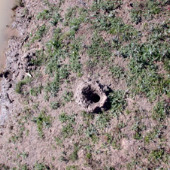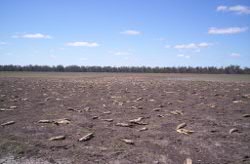|
|
River processesPeriods of high flow can be considered a form of disturbance for aquatic ecosystems e.g. flash flooding due to heavy rains. The impact of these periods often depends on the amount of water and the slope or steepness of the area. Similarly, long periods without flow or inundation can also be considered a form of disturbance to aquatic ecosystems. They lead to the constriction of available habitat and disruption of connectivity. Biota may die if the water dries completely from the location where they are living[50][19], resources can become limiting and concentrations of toxic substances can increase[25]. The intensity of biotic interactions can also increase as prey species are forced into close proximity to predators in shrinking habitats[17][11] and there is also potential for competition for limited resources to become more prevalent.  Quick facts
No flow spells Periods without flow are part of the normal flow regime of many Queensland wetlands so, in that sense, their occurrence is predictable. For a particular wetland however, the duration and timing of no flow events is highly unpredictable and linked to unpredictable rainfall patterns. They occur with sufficient frequency to be considered 'disasters' rather than 'catastrophes', in that they exert selective pressure on populations to evolve traits that enable them to persist throughout these dry times[2]. In fact, many aquatic species have evolved such traits, which increase their capacity to cope with the inevitable disturbance of spates and droughts. These enable them to either recolonise from elsewhere if local populations are eradicated (resilience traits), or else survive the disturbance in situ (resistance traits)[54]. 'Drought refugia' are locations within catchments that are subjected to reduced desiccation stress during periods without flow[7][51][6]. Comparatively little is known about drought refugia but in river systems they are known to include water in remnant pools, the hyporheic zone and crayfish burrows, plus coarse woody debris, litter and stones in the dry streambed[7][51][6]. Individuals in refugia are able to recolonise disturbed sections of the river and other off-stream wetlands via a variety of dispersal mechanisms when conditions there once again become tolerable[50][56][57][37]. The mortality of fauna caused by spells without flow is diminished if they utilise refugia and it has been suggested that the presence of refugia may be critical to the persistence of aquatic fauna[22].  Townsend et al. (1997) demonstrated a relationship between the degree to which streams are subject to disturbance and the species traits of the animals inhabiting them. Streams with a higher predisposition to disturbance were more likely to be inhabited by species with traits conferring resilience and resistance to the disturbance. This relationship was stronger shortly after large disturbances as species without the attributes of resistance and resilience were removed. The relationship between level of disturbance and species traits of fauna was weaker at sites that had many flow refugia available, implying that presence of refugia endows species with attributes of resistance and resilience otherwise lacking[54][12]. In catchments which have long durations without flow, fauna must have traits enabling them to either survive in situ or recolonise when flows return, or else utilise drought refugia. Persistent waterholes are the most evident form of refugium in aquatic systems. These become increasingly isolated the longer the period without flow lasts. Individual waterholes have different maximum durations of effectiveness as a refuge as they gradually dry so that during very long periods without flow, only the very large deep waterholes, or those that have a reliable groundwater source, persist as refuges. Water quality and habitat availability can change as waterholes dry. For instance ionic concentrations can increase as water evaporates, thermal regimes can become more severe as volume decreases and dissolved oxygen levels can 'crash' to very low levels. This means waterholes can lose their suitability as refugia before they totally dry, but such effects are likely to differ between waterholes (depending upon attributes such as morphology, orientation and connectivity to groundwater) and between species using the refugia (different tolerances and preferences). Many aquatic species within the catchment appear to rely on waterhole refugia during these dry times for their long term persistence. Another possible source of refuge in the catchment is migration into sub-service water in the form of shallow alluvial aquifers. Little is known of the use of these potential refuges. Some aquatic species also have traits enabling them to survive periods when the waterhole is dry. Such species rely on desiccation resistant adaptations for at least some component of their life history. For example, freshwater mussels persist as adults buried in the mud of dried river beds for long periods by sealing moisture within their shells and slowing their metabolism. Viviparid gastropod snails similarly seal moisture within their shells by means of a thick operculum and further reduce desiccation stress by moving under rocks or logs within the dry river bed. Many species within catchments with sporadic flow are able to recolonise from elsewhere following the return of connectivity. Waterbirds, which during flood times can breed in enormous numbers within the province, migrate over continental scales in search of appropriate conditions. Adult aquatic beetles (coleoptera) and bugs (hemiptera) are generally desiccation resistant and able to fly large distances to locate suitable aquatic habitat, thus recolonising previously unsuitable areas. Most other aquatic insects have aquatic juvenile stages and terrestrial adults. These adults are able to disperse to suitable areas and recolonise previously dry areas with new cohorts of larvae. Similarly many species of fish migrate from refugia and recolonise previously dry areas. Magnitude of spatesSize of spates for the size of the catchment is one of the factors determining sheer stress and subsequent disturbance to the physical environment and thus the magnitude of perturbation to aquatic ecosystems[31]. Disturbance and spate sizeSpates are short duration, high discharge events in streams that are usually associated with periods of heavy rainfall. They can be a major source of physical disturbance, especially in high gradient upland streams. The disturbance generated by a spate is governed by an interaction between the amount of water and the stream slopes. For example in the Wet Tropics FBP spate magnitude is very high with respect to some other provinces (e.g. Murray-Darling FBP). This (in combination with high stream slopes) implies that spates in this province generate relatively large flow velocities and tractive forces and thus represent much more of a disturbance and perturbation to aquatic ecosystems than is the case in some other provinces. This would be a contributing factor to the high heterogeneity of substrate sizes typical of this province and can be considered a driver of biological diversity. This also implies that biota in these systems must have traits of resistance and/or resilience to spates or utilise flow refugia to persist here. During spates the high heterogeneity of substrate sizes typical of this province probably results in the availability of hydraulically dead patches that are not subject to the high velocities and sheer stresses experienced by most of the stream. Biota in such refuges would avoid physical disturbance. Conversely in the Murray-Darling FBP, spate magnitude (and stream slopes) are low; which implies that spates in this province generate relatively small flow velocities and tractive forces and thus represent less of a disturbance and perturbation to aquatic ecosystems than is the case in some other provinces. The effects of spates on stream geomorphology at various spatial scales are important determinants of habitat availability in streams during the remainder of the hydrological cycle. Variability in hydraulic conditions during spates generates a mosaic of in-stream habitat patches that vary in their type, size and age. Disturbance by spates provides a variety of conditions suitable for a wide range of species and is important for the maintenance of species diversity in streams[53]. In this way spates play a major role in prescribing faunal composition and ecological processes acting in streams. In situations where community composition is influenced by biotic interactions, perturbation resulting from spates can be important in maintaining biological diversity by reducing the influence of predators and competitively dominant species[21][26][44][18]. Spates can result in a catastrophic response by stream fauna, by reducing the total number of individuals and taxon richness via mortality as well as altering faunal composition, age structure and functional organisation[8][20][30][41][42][43][46][47][4]. The action of the higher velocity water can itself displace animals[4], however, the major perturbation to benthic communities is often considered to be the mobilisation and tumbling of stream bed material leading to scour and fill[13][33][54][8] Spates and slopesIn lowland rivers spates are less of a disturbance because bed slopes are lower, depths are generally greater and thus water velocities and tractive forces are not as extreme as in upland areas. Spates also tend to last longer and are often termed floods. In these rivers, many species utilise particular conditions that are only available during spates (such as flow velocities, depths, access and connectivity to particular habitat features) for particular behaviours or parts of their life history. In general terms, the greater the frequency and duration of spates at the correct time of year, the more opportunity is available for these activities. In lowland systems, spates also play the important role of inundating floodplains and filling temporary wetlands. Re-wetting of dried sediments can release significant amounts of nutrients[55] and lead to high rates of primary and secondary production on a large spatial scale. The timing, frequency and duration of spates are major factors (along with geomorphology and geology) influencing the timing and duration of filling of temporary wetlands. These represent important habitats for many aquatic species, but because they are temporarily inundated and thus often dry, species utilising them must have adaptations for persisting through dry spells. Faunal interactions: resistance and resilienceSpates are part of the normal flow regime of most streams, so in that sense, their occurrence is predictable. For a particular stream however, the intensity, duration and timing of spates is highly unpredictable. This is particularly the case for many Australian streams as a consequence of unpredictable rainfall patterns[9]. For aquatic species to persist in a stream they must have adaptations to cope with the inevitable disturbance of spates. They must either be able to recolonise depleted populations from intact areas, or else be able to survive the influence of spates. The ability to survive a spate in situ has been termed “resistance”, and the ability to rapidly recolonise following eradication of a local population, “resilience”[24]. Species that are resistant to spates possess specialised traits such as streamlined body shapes, the capacity to cling tightly to fixed objects and the ability to dig into the substrate. These traits enable them to avoid or resist the strong tractive forces or abrasion by suspended materials associated with spates. Resilient species possess traits including mobile adult stages, habitat generalism and short generation times, that enable them to rapidly recolonise disturbed stream habitats[54]. The timing of spates is largely limited to the wet season so biota that utilise spates for some part of their life history are confined to do so during only part of the year. Conversely species that may have an aversion to spates for some part of their life history may be able to specialise in utilising the dry season. Many species utilise spates as spawning cues including Hyrtl’s Catfish and Golden Perch, and the conditions provided by them favours spawning and recruitment success. In some provinces, many species utilise particular conditions that are only available during spates (such as flow velocities, depths, access and connectivity to particular habitat features) for particular behaviours or parts of their life history. However, the reproductive success of other species is harmed by spates during the breeding season. For example, associated velocities can displace eggs, larvae and juveniles of some fish species, such as the Rainbowfish, and terrestrial nests of turtles can be flooded, killing the eggs. Platypus burrows can also be flooded, drowning the juveniles. In such examples, spates still clearly represent a disturbance. Recolonisation of depleted patches following spates can be rapid and occur from intact populations at various scales via a variety of processes that can occur simultaneously[25]. These include flight, swimming, drift, surface movement, recruitment and migration from the hyporheos and laterally from floodplain waterbodies[16][29][32][34][49][52][57][15]. There is however evidence that many aquatic species are resistant[14][1] and that during spates there are hydraulically dead patches that are not subject to the high velocities and sheer stresses experienced by most of the stream. The loss of benthic fauna is minimal in these patches, which have been termed “flow refugia”[27][28][36][48][22]. Individuals in refugia during spates would be available to recolonise disturbed sections of the stream when flow returns to lower levels. Benthic invertebrates actively move to refugia in response to increasing discharge[14][27][5]. Some species may depend on the availability of flow refugia for their long-term persistence in streams[22]. Townsend et al. (1997) demonstrated a relationship between the degree to which streams are subject to disturbance and the species traits of the animals inhabiting them. Streams with a higher predisposition to disturbance were more likely to be inhabited by species with traits conferring resilience and resistance to the disturbance. This relationship was stronger shortly after large disturbances as species without the attributes of resistance and resilience were removed. The relationship between level of disturbance and species traits of fauna was weaker at sites that had many flow refugia available, implying that presence of refugia endows species with attributes of resistance and resilience otherwise lacking[54][12]. The existence of several types of flow refugia within streams has been advocated. These include large particles such as boulders and large woody debris[53], hydraulically dead areas with low sheer stress[36][43][27], the edges of streams[45][3] and the hyporheic zone[56][35]. Pages under this sectionReferences
Last updated: 22 March 2013 This page should be cited as: Department of Environment, Science and Innovation, Queensland (2013) River processes, WetlandInfo website, accessed 8 May 2025. Available at: https://wetlandinfo.des.qld.gov.au/wetlands/ecology/processes-systems/water/river-processes/ |

 — Department of the Environment, Tourism, Science and Innovation
— Department of the Environment, Tourism, Science and Innovation


